Since the establishment of the Australian A-League in 2004, Melbourne Victory has been one of the dominant forces in the division, having won three Premiers and have been crowned Champions on four occasions. However, you have to go back to the 2014/15 season for the last time that Victory won the Premier.
New life has been breathed into the club though since the appointment of Tony Popovic in April 2021, previously dubbed the “Popa-lution” by the Sydney Morning Herald. Popovic – the former club captain of Premier League outfit Crystal Palace – didn’t have to wait too long for silverware, lifting the now-Australia Cup less than a year in charge.
Off-the-field antics threatened to derail this new era, and despite finishing in second place in the 2021/22 season, Victory slumped to a disappointing 11th-place finish last time out. However, Popovic’s side are back in the title race this campaign, sitting fourth in the division, six points off the top spot with a game in hand.
Despite only one defeat this campaign, Victory has succumbed to too many draws – nine in 16 so far. In this tactical analysis, we will assess Victory’s start to the season and focus analysis on recent matches. We will delve into Popovic’s tactics to determine how they might go about changing their fortunes to start converting their draws into wins.
Too many stalemates
A former central defender in his playing days, it is no real surprise how solid Popovic’s side is at the back. Typically lining up in a 4-2-3-1 formation, Victory has the joint-tightest defence in the division, only conceding 18 goals to date.
At face value, Victory are also strong with respect to their attacking credentials. The Australian side has scored 28 league goals. The joint top scorers in the division, Perth Glory, Central Coast, and Macarthur – who, with the exception of Perth Glory, have all played an extra game – have each only scored four more goals than Victory. It is, therefore, feasible that the Victoria-based side could soon be topping the goal-scoring charts.
Looking at the goals scored statistic doesn’t paint the full picture for the Melbourne club. A deeper dive into the distribution of goals scored per game offers more insight…
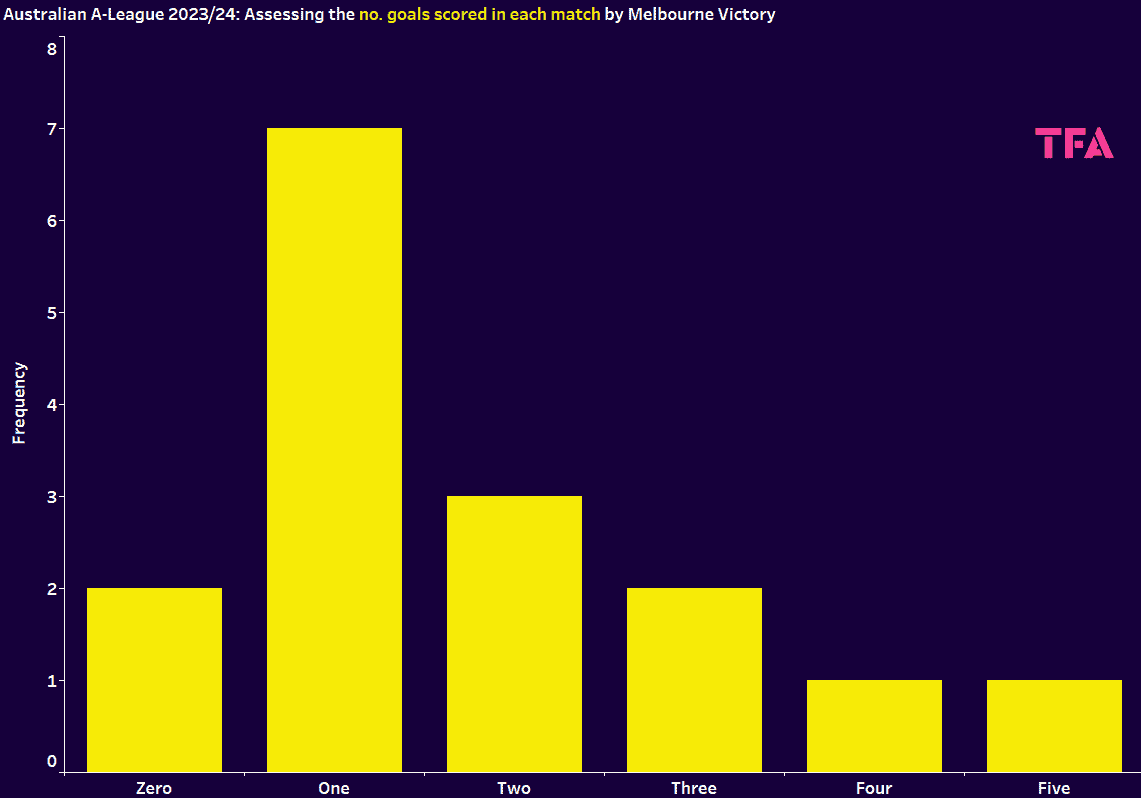
The above graph shows a skewed distribution: Victory are scoring once in the vast majority of their matches. Having played 16 matches to date, Victory has scored over 50% of their total goals in just four matches.
Popovic’s side has ironically conceded more than average in most of their high-scoring games. Victory is conceding 1.13 goals per match, and considering that, more often than not, they are only scoring one goal per game themselves, it is no wonder the Victoria side has become so accustomed to stalemates this campaign.
The following graph shows that the stalemates threaten to derail their title charge.
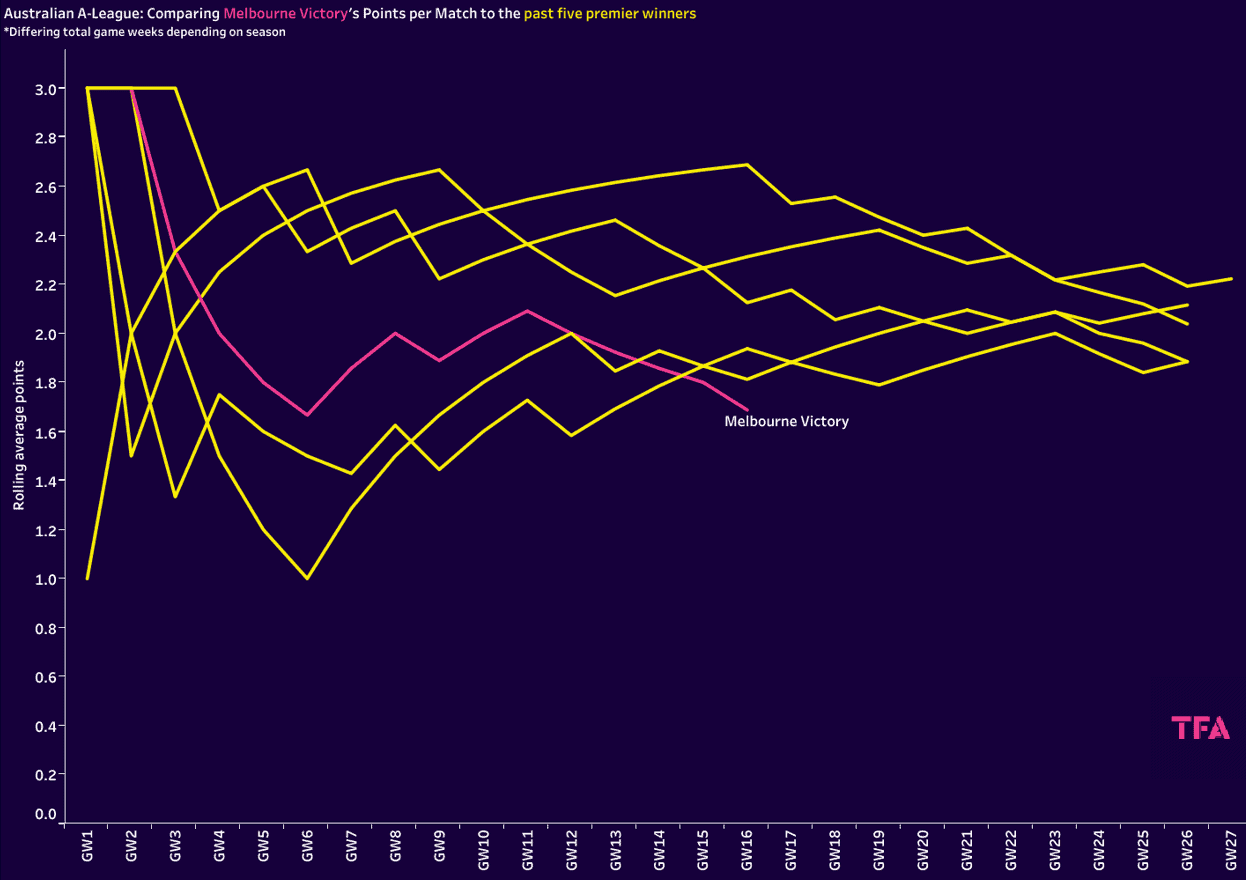
Victory is lagging behind compared to the past five A-League winners at the same stage of the season. The Melbourne side is averaging 1.69 points per game, which is lower than the previous five premier winners by the end of their respective campaigns.
With such a tight defence, Victory is far from out of the title race, though. If Popovic’s side could improve their finishing touch at the other end of the pitch, they could well become unstoppable.
There is a need for better decisions in the final third
In the past five fixtures, Victory has had four consecutive one-all draws, and in their most recent fixture, they suffered a one-nil defeat to Macarthur. Popovic opted for a 4-2-3-1 in the opening three matches of this last run of five league games before switching to a 4-4-2. In the majority of these fixtures, Victory has dominated the ball, averaging over 60% possession.
Despite the dominance, they have struggled to create opportunities in open play.
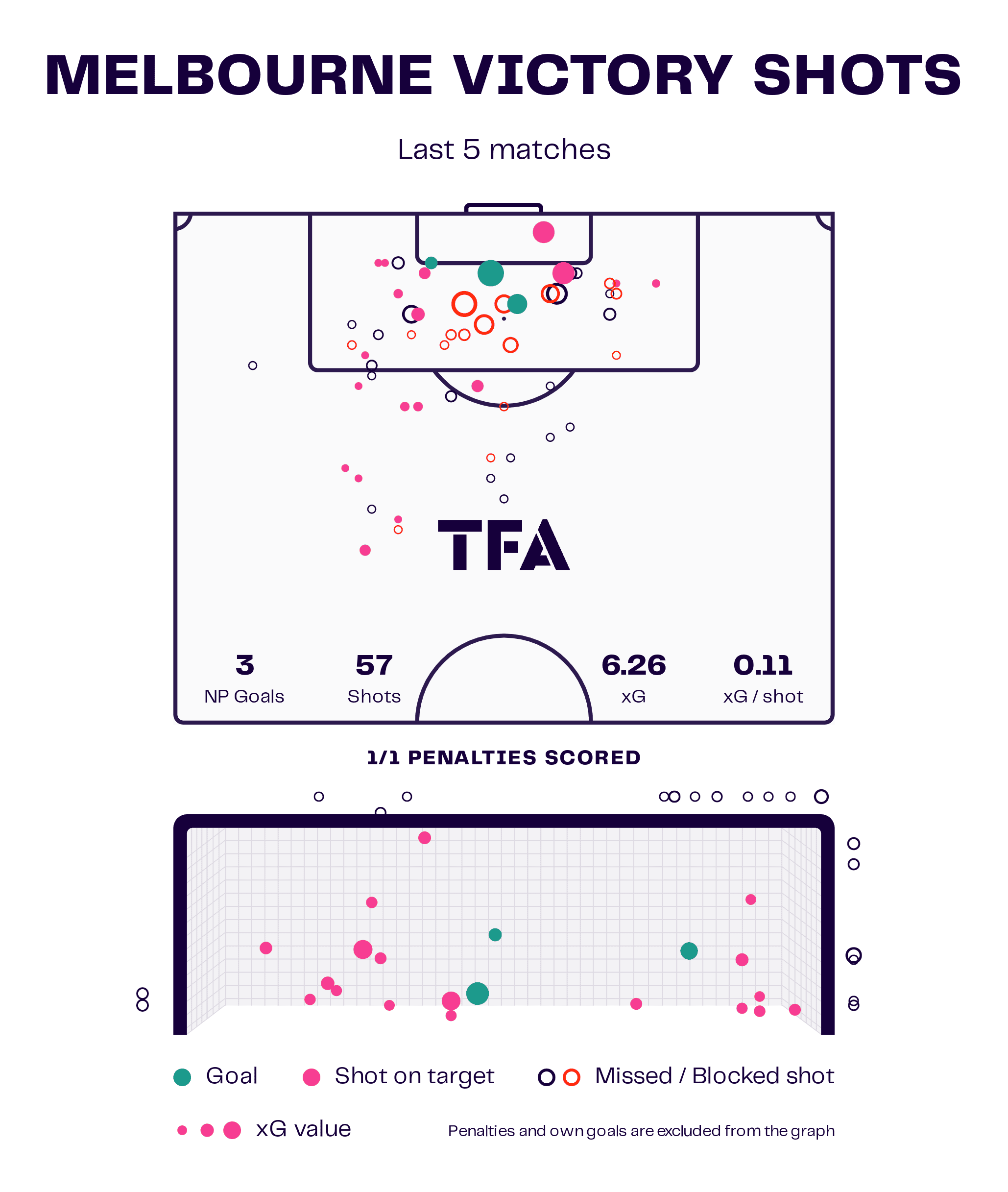
The above graphic shows that as well as being wasteful from promising openings, Popovic’s side has been restricted to long-distance shots, which, in turn, have smaller goal expectancy values. The Melbourne side’s frustrations in attack stem from struggling to break down a low block.
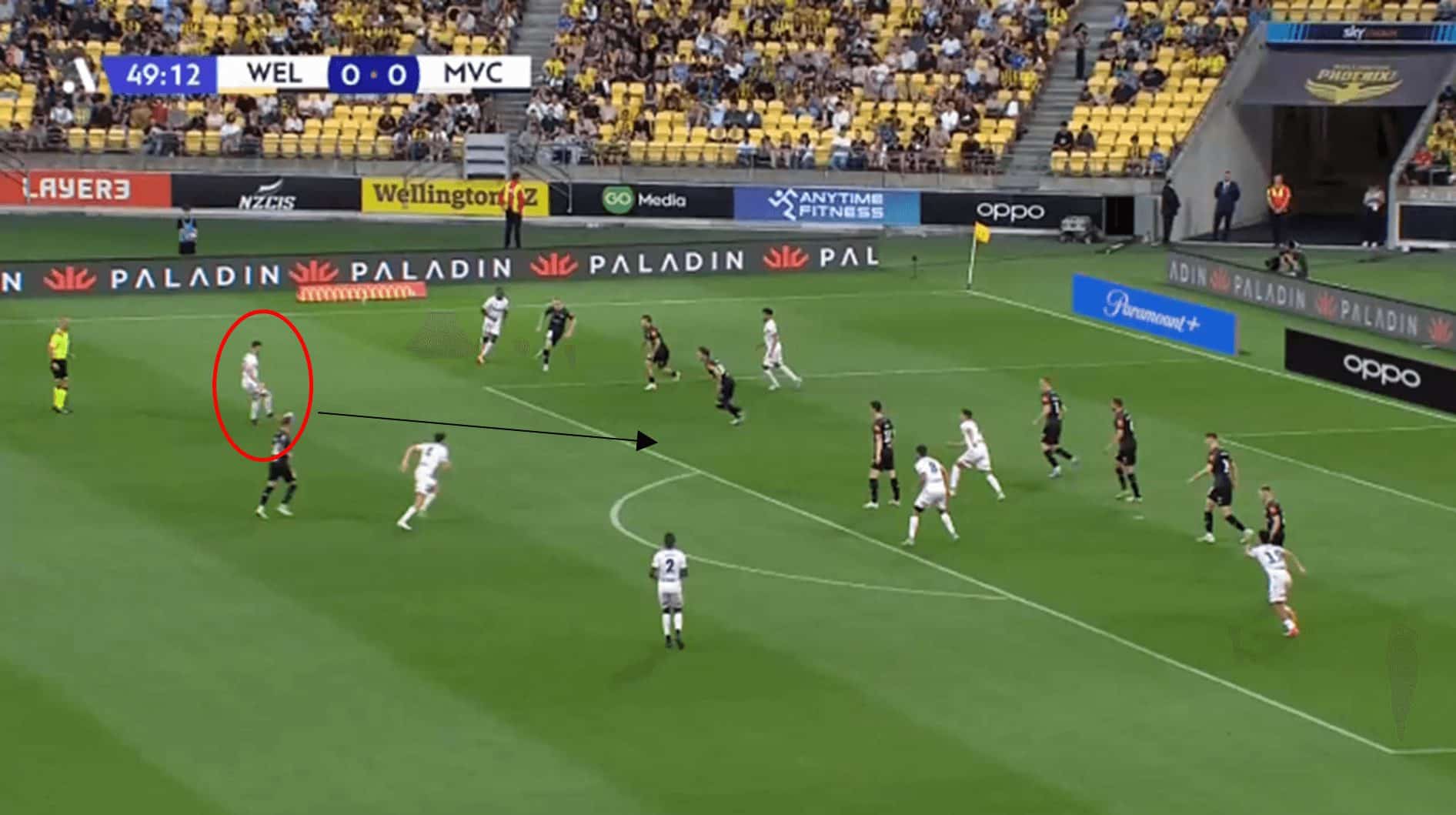
Opponents Wellington Pheonix are still defending in such a low block in the above match with two banks of four to suffocate the Victory passing options in the final third. A poor pass is made by Victory into the congested penalty area but is blocked before reaching the Victory centre-back, who attempts a long-range effort to no avail.
Victory have struggled to break down opponents defending in a low block. Although sometimes they have been able to create openings with clever one-two passing combinations near the edge of the box, it is challenging to create consistent opportunities like this when the opposition is defending so deep.
In order to break down a low block, Victory will need to increase the tempo in their passing exchanges. Their passing and movement in the final third can sometimes be very laboured. Rather than continuing to carve out opportunities within tight spaces, Popovic’s side should look to quickly distribute passes horizontally across the pitch in the more advanced areas.
This will stretch the opposition out wide and tire the opposition if the passing is executed at pace. If the opposition then starts to tire, the chances of more openings in the half-spaces for Victory to exploit will open up from gaps left in the opposing defensive line.
Of course, it will be difficult to maintain fast-paced play in the attacking phases throughout 90 minutes; however, if done well in the early stages of the match, it presents the chance for the game to be killed off early doors. Opponents will then have a mountain to climb for the remainder of the match, and Victory, in turn, would be granted greater autonomy in dictating how the remainder of the match plays out at a more controlled pace.
Victory’s reliance on trying to break down opponents centrally had led to neglecting to use the width of the pitch at times in recent fixtures.
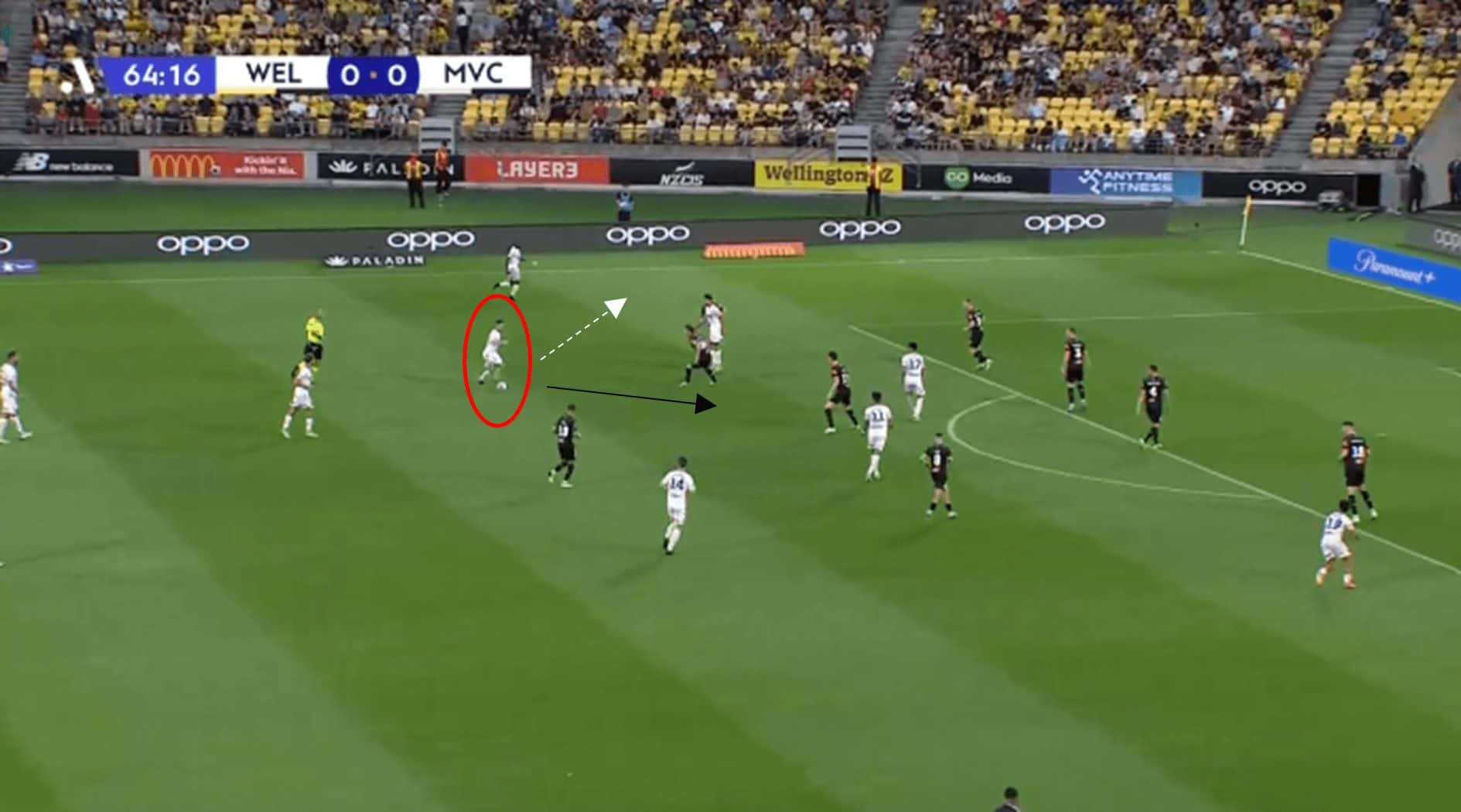
As Victory looks to create an opening in the penalty area, Wellington Pheonix has a compact shape, but there is an excellent opportunity to play the ball out wide to the left in this case. However, this option is overlooked by Victory.
Had the ball been played out to the left wing, numerous Victory players could have advanced into the penalty area looking to pounce on an incoming cross. Such an opportunity never materialised, though, due to poor decision-making. This isn’t the only case where poor decision-making has proved potentially costly, as seen in the below image.
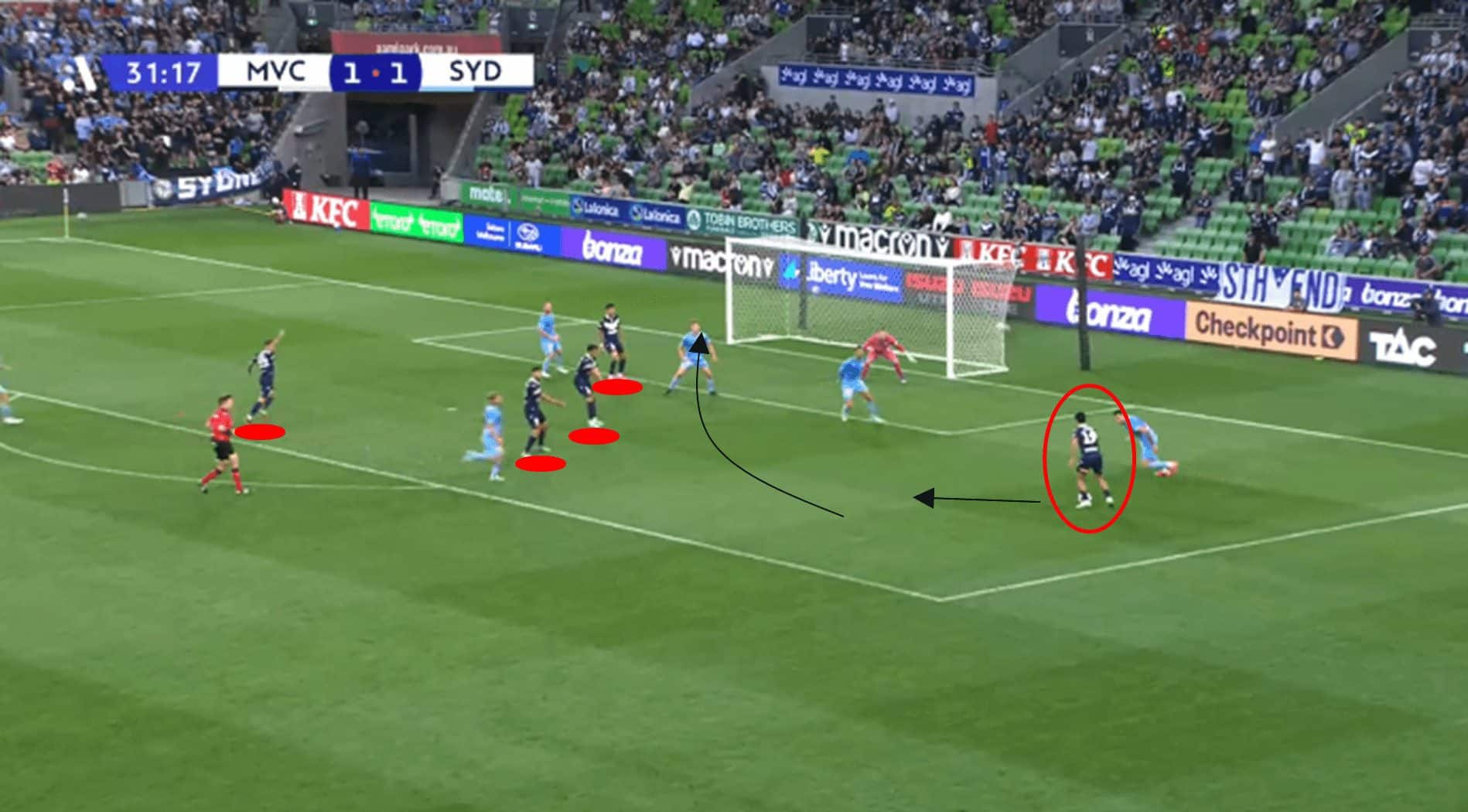
Daniel Arzani has possession on the right side and opts to cut inside before curling an effort just wide. However, given the numerous options available in the box, with teammates calling for a pass due to the amount of space they had in promising central areas, Arzani’s decision to go it alone was the wrong one.
As well as Arzani, one player who will prove key in improving Victory’s attacking output is Zinédine Machach. For the majority of the campaign, Machach has operated in the number 10 role in the 4-2-3-1, and more recently, he has been deployed as one-half of the front two in a 4-4-2.
Particularly when playing that number 10 role, Machach has a lot of freedom on the pitch but is a key component in providing a link between the double pivot in midfield and the sole forward. Machach will look to drop deep to become involved in the play and has been known to provide an outlet for one-two passing plays.
The Frenchman has played well this season and ranks in the 88th percentile for dribbles per 90 compared to others in the same position. However, his possessional play is not so effective. Machach ranks below the median compared to his peers for dangerous passes per 90 and only just above the median for progressive passes per 90.
Such possessional statistics have ensured that Machach has been less effective in aiding in the attacking phases in recent matches.
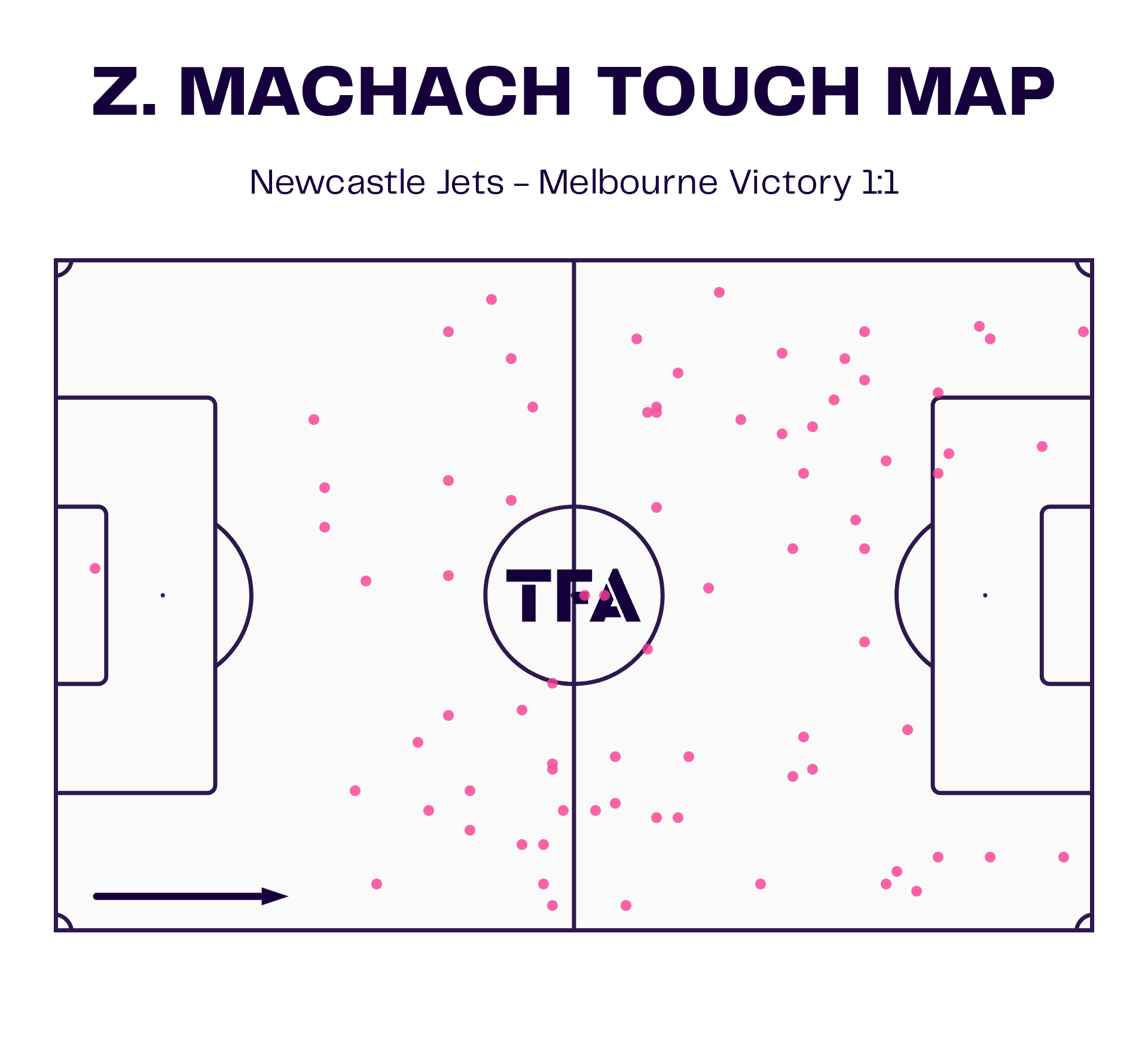
An example is in the recent fixture against the Newcastle Jets. As seen in the above graphic, Machach only had three touches in the opposition penalty area despite featuring for the full 90 minutes. Moreover, Machach has not made many progressive runs into the penalty area to support his attacking partner in the last five games.
Considering Machach is deemed a huge cog in Victory’s attacking play, the passing and movement of the forward will need to improve if the Victoria side’s attacking fortunes are to change. Machach is content to sit too deep at times and needs to look to drive play forward on a more regular basis.
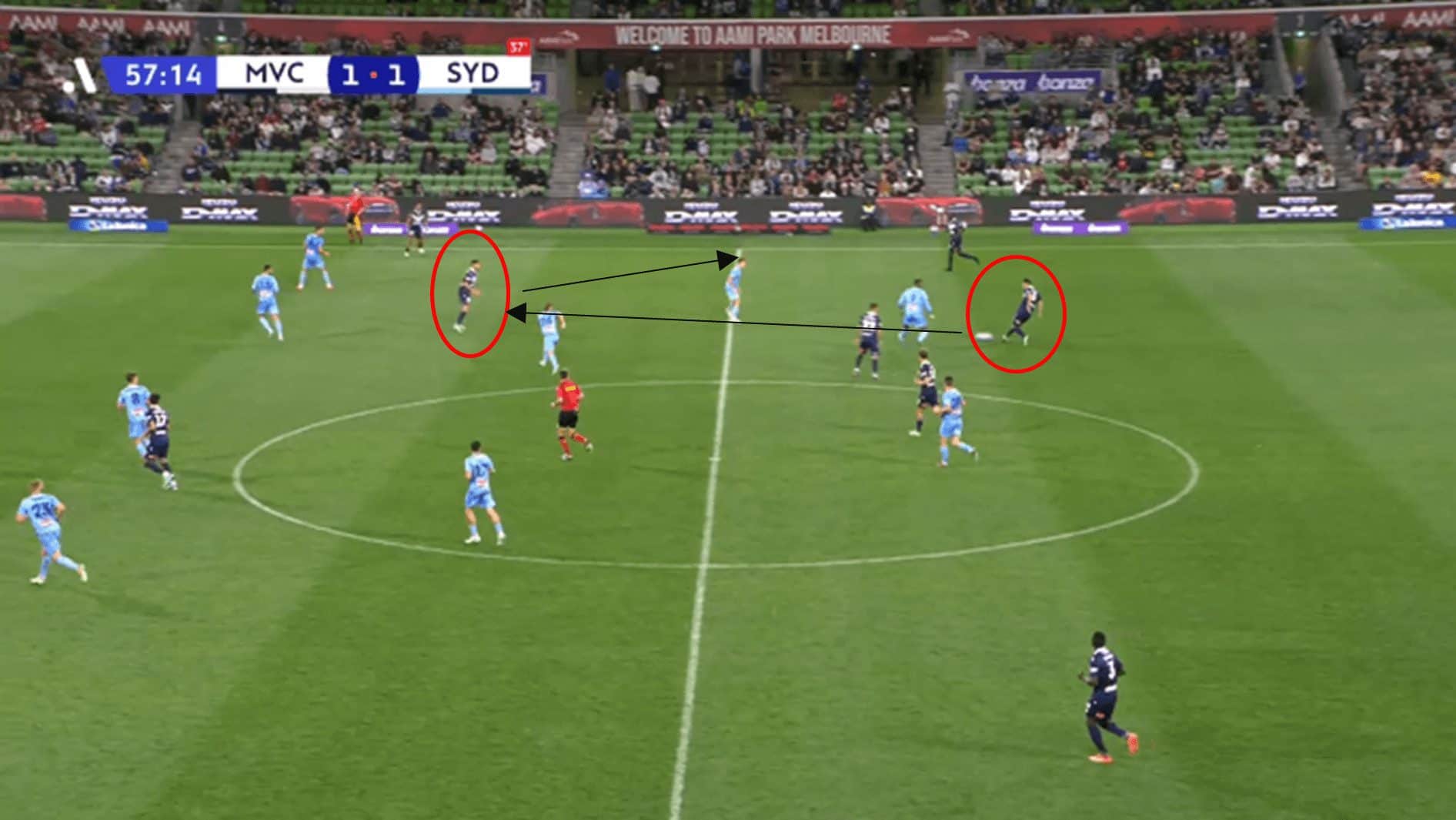
In the above match still, Machach receives the ball in a decent area, finding a pocket of space between the defensive line and the midfield. However, prior to the pass being played from the Victory defence, Machach does not complete a pre-head check to see what his attacking options are when he receives the ball.
The Frenchman’s vision is fixed on his less advanced teammates, so he opts to play the ball back to the right-back. However, Sydney are able to then block off any passing options down the right-hand side. What could have been a promising Victory attack, ground to a halt.
If Machach had looked at the attacking options before receiving the pass, he would have been aware he had the space to turn on the ball, drive forward, and potentially play a progressive pass for the advancing right-sided attacker. Simple awareness and greater confidence with the ball may have resulted in opening up the Sydney defensive line.
An example of an effective pre-head check from a number ten is Manchester United’s Bruno Fernandes below.
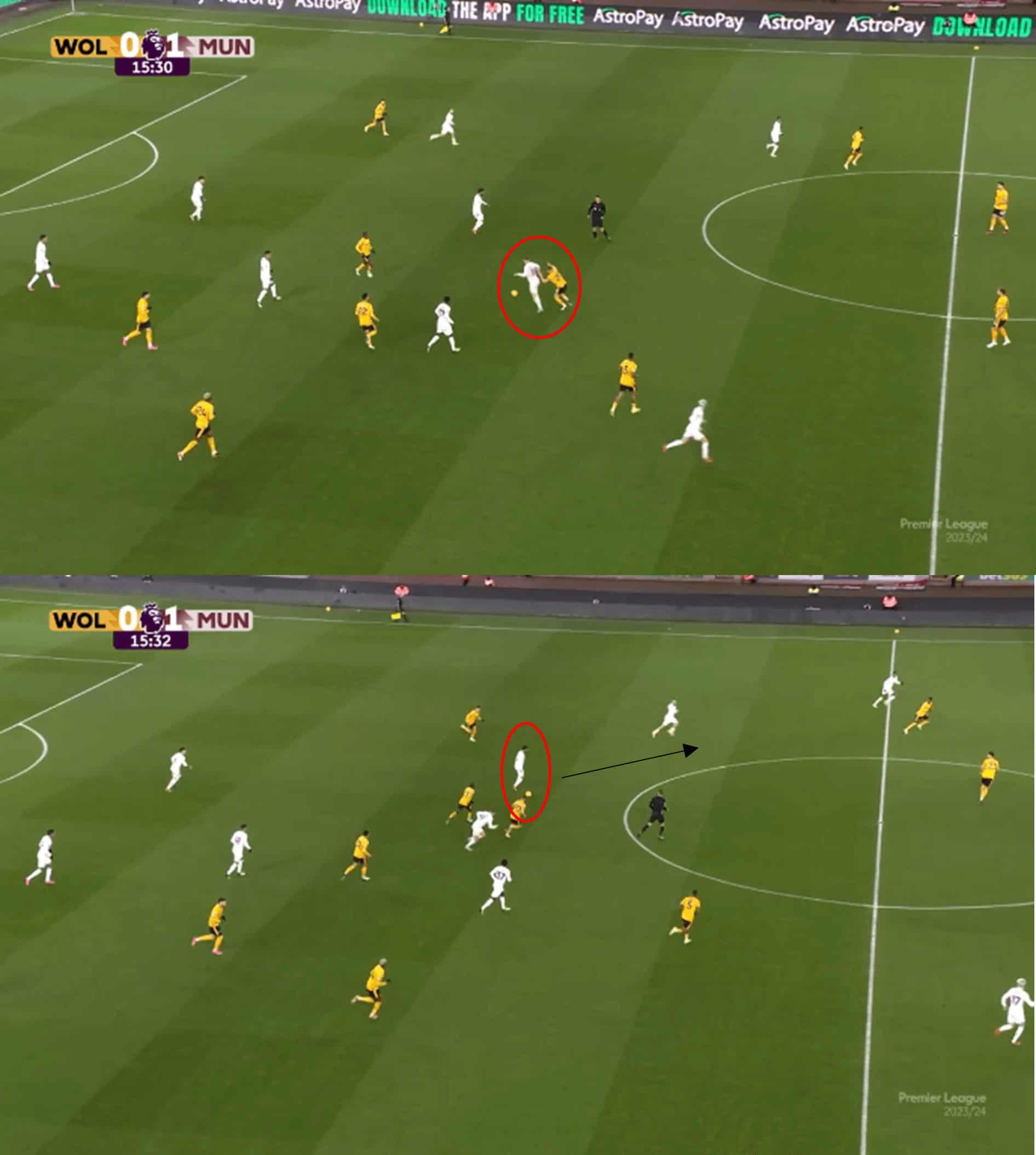
As United wins possession, Fernandes anticipates the ball being played his way, and before the pass is made, he checks his options to the left, where Luke Shaw is advancing. Upon receipt of the ball, Fernandes then passes to Shaw, allowing United to break Wolves at pace.
This is just one example of how important it is to be aware of those around you with and without the ball. An overall visual of the space on a football pitch can give a significant advantage.
Conceding too many late goals
As Victory has struggled to see off opponents in an attacking sense, lapses of concentration at the back have proved costly recently. In their last six games, of the seven goals Victory have conceded, four have been within the last five minutes of games.
As a consequence, Popovic’s side have dropped six points. It goes to show the fine margins in football, as with these six points, Victory would sit at the top of the league.
A positive aspect of Popovic’s approach to games is his management of players during the match, as he will look to make substitutions relatively early on in games, leaving players enough time to have an influence.
However, despite this approach, there have been noticeable lapses of concentration in the back line late on in games. A look at the goals conceded in these matches shows that, often, sizeable gaps are left between the players in the Victory back four.
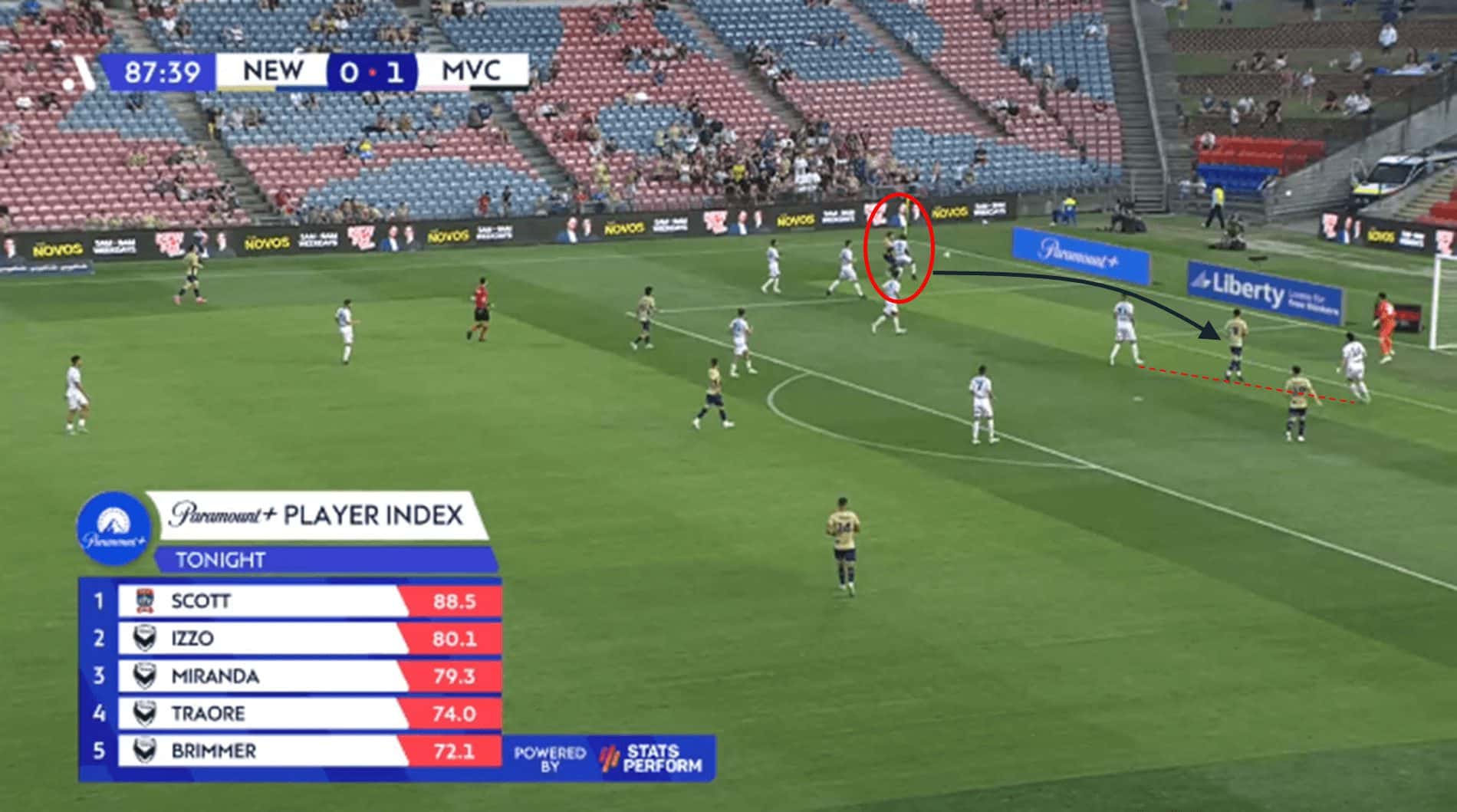
In the above image, the cross from Newcastle Jets is met by Apostolos Stamatelopoulos, who equalises. The Jets forward exploits the space between the Victory centre-back and left-back. This isn’t the only time that such space has been left between these players…
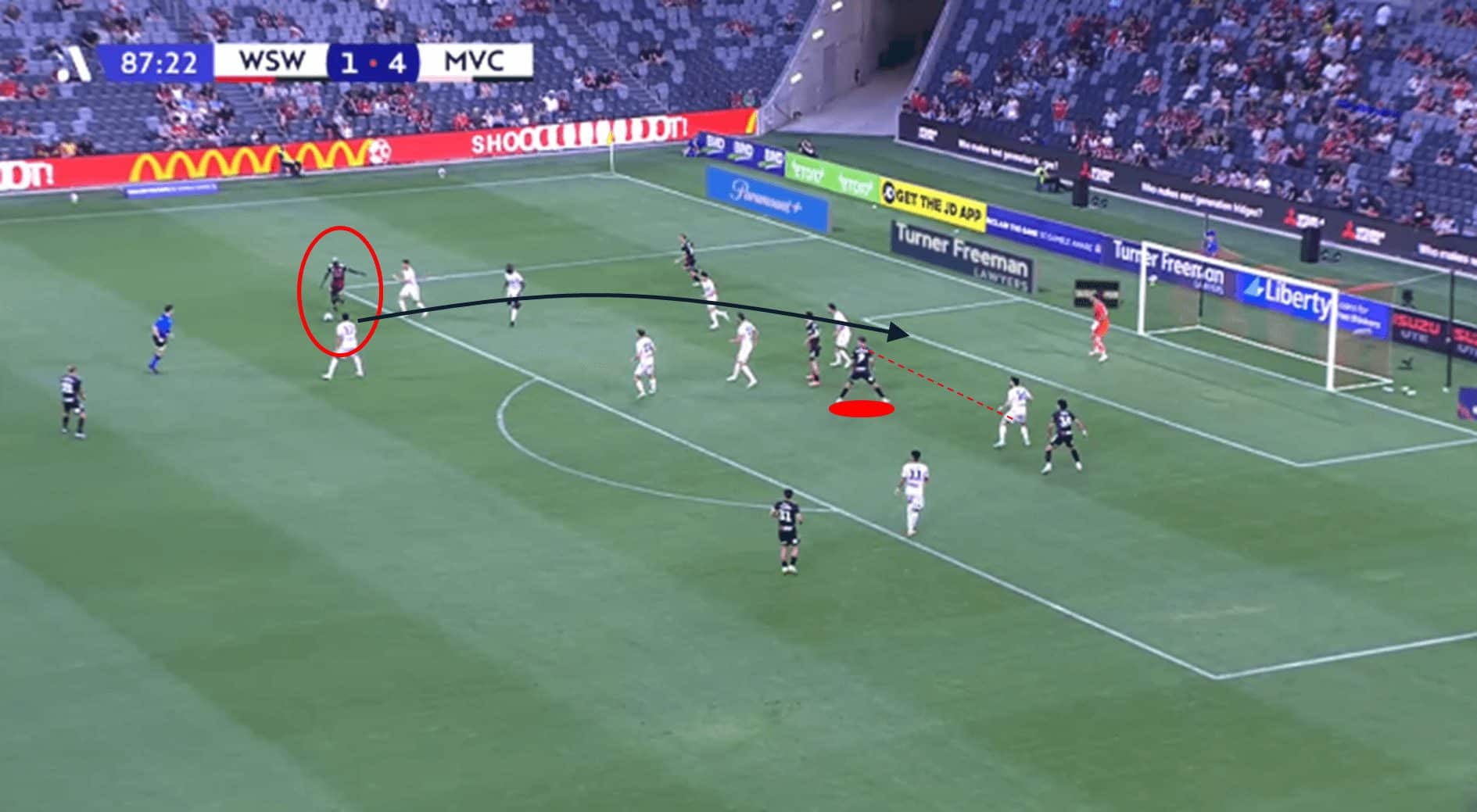
Although this particular goal didn’t prove to be costly in terms of the match outcome, Victory gifted a goal to Western Sydney as Marcus Antonsson moved into the vacant space in the defensive line and found the back of the net following a cross.
The Victory back four, in this case, lost discipline with positioning as the back four shifted across. This, however, in turn, left the opening for Antonsson as Stefan Nigro couldn’t afford to leave his marker at the back post.
It shows that communication and organisation, although simple concepts, are important throughout the full 90 minutes. Victory has felt the consequences of not abiding by these concepts of late and will need to improve if they are to sustain their current title bid.
Conclusion
In this tactical analysis, we have shown that although Melbourne Victory is a tough team to break down and concede few goals, they have struggled late to break down teams. However, this analysis has provided solutions to attacking low blocks and highlighted room for improvement in the final third with respect to decision-making as well as how to utilise space and movement efficiently.
It has further been shown that greater concentration in the Victory back line in the closing stages of matches could prove to be the difference. With roughly a third of the season remaining, Victory are still well within this title race. With some adjustments, there’s no reason the A-League trophy couldn’t return to AAMI Park and ignite the “Popa-lution” once more.






Comments